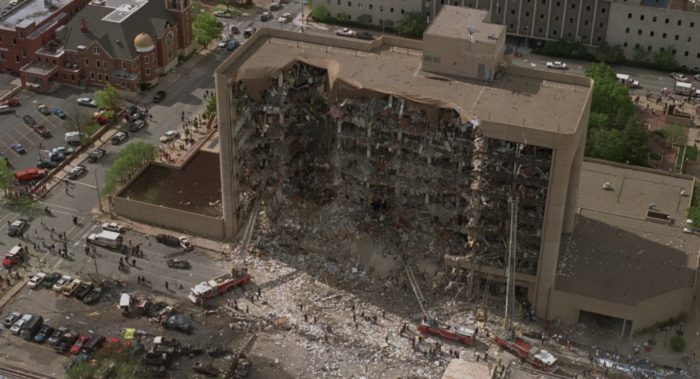(Ken Silva, Headline USA) Last February, Utah attorney Jesse Trentadue sued the FBI for records about an undercover informant who helped fund the Oklahoma City bombing, as well as for records about a neo-Nazi bank-robbery gang also involved in the attack—the deadliest domestic terrorism event in U.S. history.
One year later, the FBI hasn’t produced many records. And according to Trentadue, hardly any of those records have been responsive to his Freedom of Information Act request, which he filed over a decade ago.
Trentadue’s FOIA request seeks pertains to two FBI investigations: BOMBROB, which was an investigation into the Aryan Republican Army, the neo-Nazi group linked to the OKC bombing; and Operation Punchout, which was ostensibly intended to apprehend dealers of stolen military equipment. One of the FBI informants from Operation Punchout went on to befriend OKC bomber Timothy McVeigh.
According to Trentadue, the FBI told the court that it had commenced producing the documents at the rate of 500 pages per month.
UPDATE: We're nearing the 1-year anniversary of Jesse Trentadue's lawsuit against the FBI for records on the Aryan Republican Army and an FBI informant named Roger Moore, who was also friends with Tim McVeigh.
To date, the FBI has produced few records, and even fewer of them are… https://t.co/9HHJXMjbn8 pic.twitter.com/hUBeKVnpHW— Ken Silva (@JD_Cashless) February 5, 2025
“Over the past seven months, however, the FBI has produced just 15 pages of responsive documents, and all of them relate to Plaintiff’s BOMBROB FOIA,” Trentadue said in a Wednesday court filing.
“The FBI has yet to produce a single document in response Plaintiff’s Operation Punchout FOIA. Instead, the FBI has given Plaintiff 2,271 pages of filler having no relevance to the subjects of his FOIA Requests,” Trentadue added.
At the rate the FBI is producing documents, Trentadue said it would take over 2,500 years for him to receive all 69,375 pages of BOMBROB and Operation Punchout documents that he requested in 2015.
“At a production rate of just two responsive documents per month, it will take over 2,500 years for Plaintiff to receive these documents. That is outrageous. It is also, as a matter of law, a denial of Plaintiff’s FOIA Requests,” Trentadue said of the situation.
“More importantly, if by some miracle Plaintiff is still alive 2,500 years from now, he will most likely be in an assisted living facility and unable to understand the significance of the documents that the FBI is so desperately trying to conceal from both him and the American public.”
Trentadue asked the presiding judge to have the FBI “fully comply with its FOIA obligations.”
Trentadue’s Quest for Justice
Trentadue has been suing the U.S. government for OKC bomb-related records for nearly 30 years, ever since his brother was murdered in a federal penitentiary. The complex story of how the death of Trentadue’s brother relates to the OKC bombing can be read in this Mother Jones article.
One of the key players Trentadue seeks info about is a man named Roger Edwin Moore (not the James Bond actor), who was an FBI informant as part of the bureau’s 1980s- and early 90s-era Operation Punchout. In the early 90s, Moore met McVeigh. The two would become business partners, embarking on the national gun show circuit in 1993.
“According to Terry Nichols, one of McVeigh’s accomplices, not only did Moore provide them with the Kinestik explosives used to detonate the bomb that destroyed the Murrah Federal Building, but Moore also told McVeigh that he knew McVeigh ‘would put them [the Kinesteik] to good use,’” Trentadue said in his Wednesday court filing.
Along with Moore, Trentadue also continues to seek info on the ARA.
In 2001, then-Indiana State University criminologist Mark Hamm published a book making the case that the ARA helped carry out the bombing. Hamm’s In Bad Company: America’s Terrorist Underground detailed the movements of McVeigh and the ARA throughout 1993 and ’94, showing that the bomber was often in Arizona, Kansas and Oklahoma at the same time as several other ARA members. McVeigh and ARA members were also both spotted by witnesses at Elohim City, a white nationalist compound in the Ozarks.
Even more shocking, Trentadue later uncovered evidence that the ARA may even have been an FBI front group. Trentadue obtained an email from former FBI agent Don Jarrett—who investigated right-wing terrorism in the 1990s—saying that the Aryan robbers were thoroughly infiltrated by FBI informants.
In his current lawsuit, Trentadue expressed his belief that the ARA was indeed an FBI front group.
“Timothy McVeigh participated in some of those robberies and is reported to have used money obtained from these crimes to help fund the bombing of the Murrah Federal Building in Oklahoma City on April 19, 1995. Members of the ARA also assisted McVeigh in carrying out the bombing of the Murrah Federal Building,” he said in his complaint last February.
“The ARA was actually a front group created by the FBI in which the Bureau had embedded at least one informant.”
Meanwhile, Trentadue still has another lawsuit against the FBI for records about the OKC bombing.
That lawsuit, which has been ongoing for decades, seeks surveillance footage of the blast. The FBI has denied that such footage exists, but Trentadue has evidence to the contrary—including a Secret Service investigative memo that describes the surveillance footage.
Trentadue’s lawsuit went to trial in 2014.
There, he was to have FBI informant-turned-whistleblower John Matthews testify on his behalf about how the bureau was monitoring McVeigh in the lead-up to the attack. However, Matthews changed his mind about testifying the night before he was supposed to take the stand, leading to Trentadue alleging that the FBI engaged in witness tampering and threatened Matthews.
Trentadue’s allegations have been subject of a court-appointed investigation for the last nearly eight years. The investigation has been conducted behind closed doors, with gag orders on all parties.
Ken Silva is a staff writer at Headline USA. Follow him at x.com/jd_cashless.

